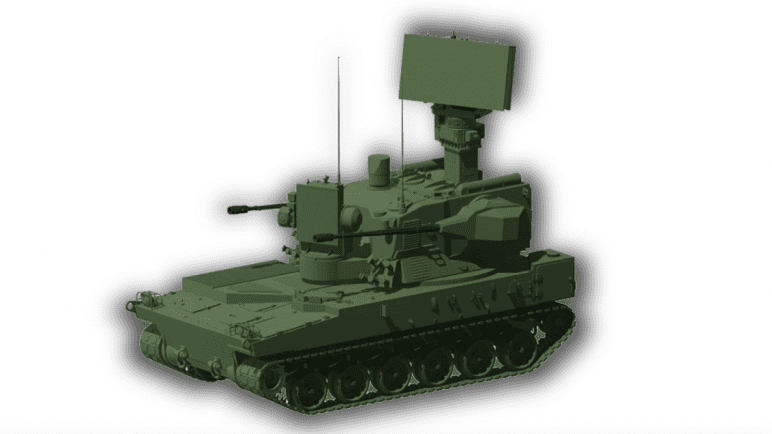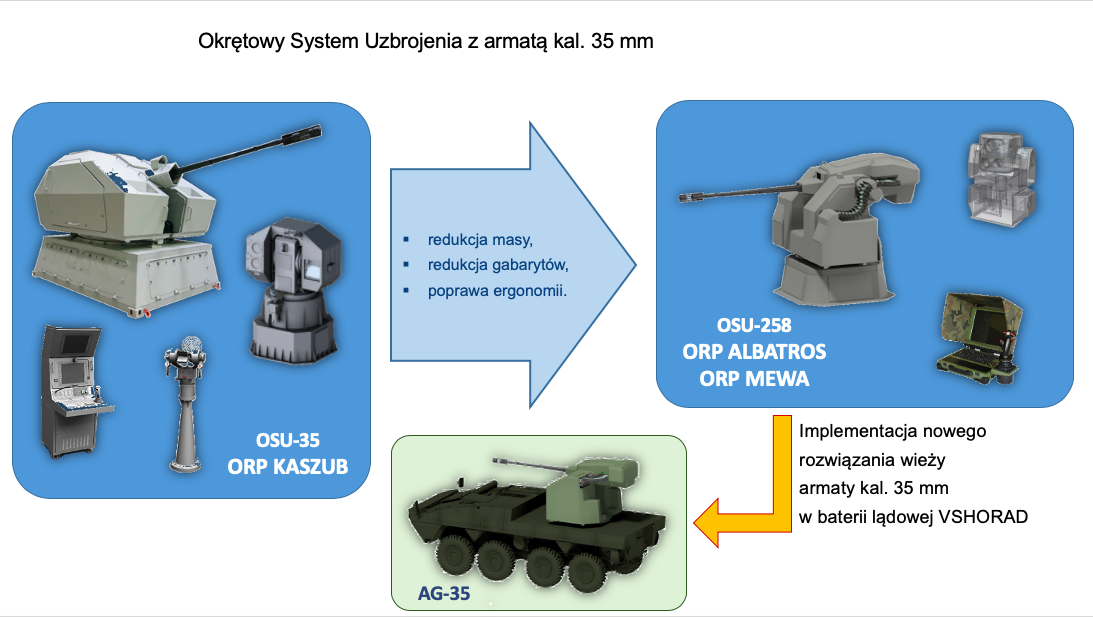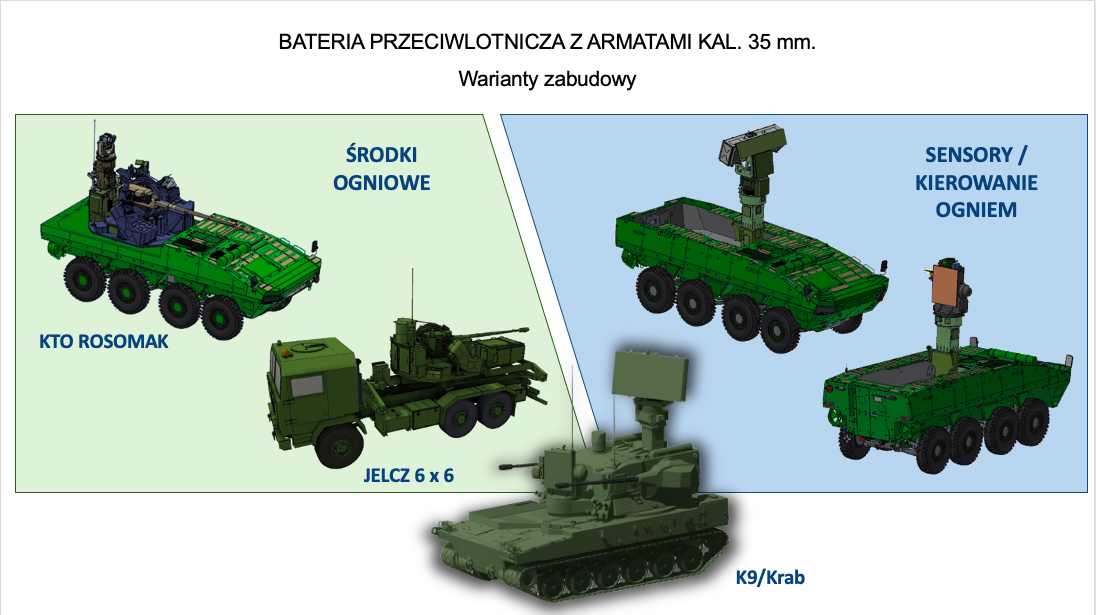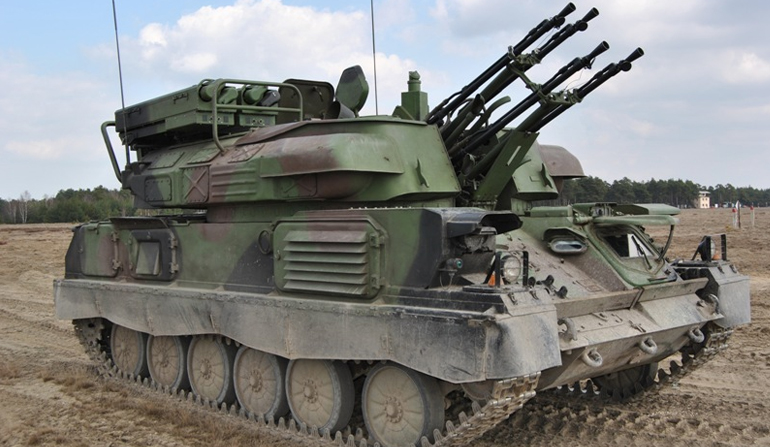Polish 35 mm Artillery System - Configuration Potential

Responding to the evolving contemporary battlespace, and to the requirements defined within numerous defence procurement programs, the 35 mm artillery system developed by PIT-RADWAR along with the programmable munitions developed by the Polish industry is being readied for implementation in a myriad of configurations. The first version of the system, with the 35 mm gun (OSU-35), has already become a part of the inventory of the ORP Kaszub corvette. Several land variants, integrated on different platforms, have been considered as well. Making the 35 mm calibre systems common and broadly introduced in the Polish military could lead to a capability leap in the VSHORAD area, providing the air defence units with an entirely new set of assets. Furthermore, the introduction of those systems may also make it possible to withdraw the obsolete S-60 anti-aircraft guns.
The 35 mm artillery system developed by PIT-RADWAR has already been fielded in its naval variant, onboard the ORP Kaszub corvette. The system is also going to be installed on another two Kormoran-class MCMVs. The land-based variant is being developed in parallel. The system is going to come both in a towed-variant (Noteć programme pursued by the PGZ-Noteć consortium, formed by the PGZ Group, PIT-RADWAR, and HSW), as well as in varieties integrated on self-propelled platforms of several types - in line with concepts developed by PIT-RADWAR autonomously. Some of those concepts could become a viable option in the SONA programme, recently announced by the Armament Inspectorate. SONA is a project aimed at providing means of direct air defence to armoured elements, also in the C-RAM domain.
Several potential configurations of the system have been conceptualized. Not only could they be interesting to the Polish military, as they also exhibit a significant export potential. A Polish system of programmable ammunition is being developed along with different variants of the gun.
The solution or solutions offered by PIT-RADWAR are a complex set of anti-aircraft systems built around the 35 mm automatic cannon with a two-sided feeding system, fire control systems, and sabot/training/programmable rounds developed in Poland, in collaboration with the Mesko facility. The latter is especially relevant, as the programmable (ABM, air-burst munition) rounds are a means that is especially useful in acting against smaller airborne threats, such as UAVs for instance. The gun still retains the ability to fire sabot rounds. Not only are these an effective asset in acting against conventional airborne threats, but they can also be employed against non-armoured and lightly armoured land and naval targets. The systems using the 35 mm gun come in variants. They can utilize components already offered by the Polish defence industry, such as wheeled/tracked carriers (JELCZ, ROSOMAK, LEOPARD, K-9), communications/datalink assets (ŁOWCZA/REGA, upgraded ZENIT system, radars (SOŁA/BYSTRA), as well as solutions that are entirely new.

Base Platform - Accurate Gun with Polish-Made ABM Programmable Rounds
Back in 1995, within the framework of the PZA Loara AAA development program, Poland procured a license to manufacture the KDA 35 mm gun from the Oerlikon company (currently a part of the Rheinmetall business). The procurement has become a starting point for the whole programme aimed at the development of a myriad of 35 mm artillery systems. The manufacturing has been assigned to HSW S.A. One of the most important features of the cannon, apart from its being very accurate, is the ability to feed ammunition at both sides, which makes it possible to quickly alternate between the sabot and programmable rounds.
Programmable ABM detonation greatly increases the effectiveness of use. In some systems, the rounds are programmed when fed into the gun mechanism based on statistical measurements stored within the computer memory, or on the measurement of the velocity of the preceding rounds and the target parameters. PIT-RADWAR, working with Mesko, has designed a more effective, yet more complex system. The round is programmed in a non-contact manner when leaving the barrel. Thanks to the above UAVs can be destroyed with just a single shot. The effectiveness of the programmable ABM ammunition has been confirmed through a test programme carried out by PIT-RADWAR S.A. within the framework of “Bateria przeciwlotnicza 35 mm” [35 mm anti-aircraft battery] project, back in September 2019. The tests took place at the Central Air Force Training Range in Ustka. The tests involved shooting an airborne target with programmable rounds. The targets were hit, in line with the programmed parameters.
Programmable rounds remain fairly effective against a broad, yet clearly defined range of targets. Here we are referring to airborne, land, and naval threats. This group also includes light armour, as the programmable ABM rounds can pierce armour as well. Due to the high initial velocity, the range of sabot rounds is greater than the one of the programmable munitions. The shorter time required to reach the targets may be crucial when shooting at maximum range. The range, in case of the 35 mm gun with a programmable round is defined as 3.5-4 kilometers, whereas if sabot rounds are used, the range is extended up to 5-6 kilometers.
Due to the high level of accuracy of the PIT-RADWAR’s targeting system, as well as due to the gun design itself, the cannon provides the user with a high level of accuracy when used against targets within the effective range. This also applies to smaller threats moving at high speeds, such as cruise missiles, UAVs, or guided rockets. Precision and accuracy are a relevant factor here, with the hit groups being small in diameter. This makes it possible to directly hit the targets or to detonate the rounds at a distance that provides the user with almost a certain neutralization and destruction of the threat.
35 mm - Naval and Land Applications
All of the weapons systems offered by PIT-RADWAR and described below are derived from the “Loara” anti-aircraft artillery system project developed in the mid-1990s. The project resulted in the development of a self-propelled system based on the modified T-72 MBT, armed with two 35 mm KDA guns using an early warning radar and a tracking radar coupled with optronic sensors for targeting purposes. The project came to an end after the MoD made a relevant decision to do so, in 2009. A single example of the product was introduced into the inventory of the 10th Armoured Cavalry Brigade. Nonetheless, it was withdrawn after a couple of years. PIT-RADWAR has developed several armament manufacturing concepts, based on its experiences. This was to address the needs of both the Navy, the Army, as well as those of potential export customers.
So far the naval variant of the gun (OSU-35 ship armament system) has been the sole existing derivative of the system successfully introduced into use, alongside the Loara. The system is housed in an unmanned turret installed on the warship with minimum modification of the structure of the vessel; the turret has been fitted with a stabilized 35 mm gun. The turret also accommodates 2x100 rounds of ammunition. The system itself also includes a fire control system with an operator station, a reserve control station, and a day/night optronic sensor also fitted with IFF.
The experience gathered throughout the project and the test program led to the development of a new version of the system, also known as OSU-35K. This derivative has been adopted for installation on two new Project 258 (Kormoran II class) MCMVs: ORP Albatros and ORP Mewa. Integration works have already begun on the former vessel. These are scheduled to last around 2 years. Work on integration of the system on ORP Mewa is also in progress at the moment. OSU-35K is much lighter and it also exhibits much better ergonomics. The system’s optoelectronic sensor has also been modified and upgraded, along with the fire control system and the operator’s station.

Optimization and miniaturization of the OSU-35K system and weight reduction have made it a good starting point for a land-based, self-propelled VSHORAD solution. The stabilized turret system and the fire control system of the naval variant make it possible to carry out engagements from a moving or stationary platform. The compact design is useful in adopting the system on any customer-selected carrier platform. It can be installed on the Rosomak APC for instance, so common in the Polish military. However, integrations on trucks or on a tracked platform are possible as well.
Land-Based Transportable Batteries
After the Loara programme came to an end PIT-RADWAR decided to continue its efforts in the AAA domain. Within the period between 2009 and 2011, with funding provided by the Ministry of Science and Higher Education “Remotely Controlled Anti-Aircraft System based on a 35 mm Cannon” project has been implemented, and the relevant product has been created by the consortium formed by the Military University of Technology, PIT-RADWAR and Research and Development Centre for Mechanical Devices from Tarnów. “Zdalnie Sterowany System Przeciwlotniczy Kalibru 35 mm”, also known as ZSSP-35 “Hydra” was the result of the aforementioned initiative. The weapons system mentioned above has been presented several times during the Kielce MSPO Salon. The system was rated positively by the leadership of the air-defence component at the Polish Ministry of Defence, as well as by the Command of the Armed Forces.
Back in 2014, the concept of the battery structure was redefined. The design was updated with further battery components. The effector is the 35 mm cannon based on a towed, yet automated platform - the A-35 variant comes with a programmable sight, while the AG-35 comes with a fire control system of its own with an optronic sensor. Detection and guidance, and fire control systems have been installed on the Żubr vehicle, forming a WG-35 fire control vehicle. The vehicle has been fitted with a hydraulically extending optronic sensor that is just another variant of the sensor installed in the modernized WD-95 modernized BLENDA air defence system command vehicles. The sensor suite features a III gen. thermal imaging sensor, a daytime camera, a high-frequency laser rangefinder, and an IFF interrogator. The WG-35 vehicle has also been tailored for additional integration of a tracking radar that is a subject of fairly advanced works taking place at PIT-RADWAR. The radar would make it possible to detect and track targets in any weather conditions.

The system above is a scattered form of the PZA Loara solution but divided into individual components. Using a fully automated effector platform has been a result of the plans made by the Navy to replace the towed 57 mm S-60 guns using the PIT-RADWAR Blenda fire control system. Thus, a modern solution that would be far more effective, without changing the system-movement-associated logistics, would be introduced. Noteć programme also had a relevant impact on the direction of development of the system. The initial goal was to procure an artillery asset, and only after the Armed Forces defined their requirements, the objective was changed, and a complete battery system was the main product expected to be obtained. The analysis within the scope of that programme is being pursued by the Armament Inspectorate. In the meantime, the AG-35 gun was integrated within the Pilica system, ordered by the Armament Inspectorate a few years back, to protect the airbases. The gun offered by PIT-RADWAR is fully capable of working with the system. Thanks to the above Pilica could have its potential enhanced, by using the NATO-compliant 35 mm round alongside the lighter 23 mm assets.
There is no doubt, however - the 35 mm guns can be used in a much broader scope, beyond the realm of the coastal air defence units of the Navy that are the main focus of the Noteć programme. A weapon as such could be an effective complement of the missile-based air defence solution. It could be employed against both low-flying threats, as well as UAVs or rockets/missiles, protecting important elements of the infrastructure or even the Wisła and Narew systems batteries.
Self-propelled Batteries
Thanks to the modular nature of the 35 mm system, it is possible to embed it within any selected turret, on any kind of a self-propelled platform. The conceptual design works within that scope have led to the emergence of self-propelled variants as well. Some of them have evolved directly from AG-35.
The simplest way would be to install the AG-35 turret coupled with an optronic sensor on a high-mobility truck such as the Jelcz S-662. Along with the WG-35 command vehicle installed on an identical platform the battery of this kind would offer capabilities identical to the towed variant. However, it would also be highly mobile. Additional ammunition carrying capacity would also be obtained. The system, configured in this manner, could also be used as an escort system in convoys, with extra capability against the land targets.
A solution that would be even more advanced could involve the integration of the AG-35 system on an armored platform (or other turret fitted with a 35 mm gun and optronic sensor). Rosomak APC seems to be the natural candidate that fits this role in the Polish military - as depicted below. In this configuration, the 35 mm artillery system could be used to protect motorized infantry units utilizing the very same vehicle type. Apart from the artillery suite, it would also be possible to integrate the fire control system identical to the one installed on the WG-35 platform. However, the Rosomak-based system could also feature a hydraulically extended sensor system fusing radar and optronic sensors.

A variant of Soła or Bystra radars or the Poprad SAM system could also be integrated on the Rosomak APC. One needs to remember that the WG-35 vehicle can be used for fire control purposes in a mixed battery formed both by the 35 mm cannons with ABM rounds, as well as the Poprad SAM systems using the VSHORAD missiles. Platform-unification would make operational use of such a system in mechanized or motorized units easier. It is also possible to utilize a different carrier platform, be it wheeled or tracked one, should the customer have requirements as such. All of the aforesaid elements have been used already, either in the 35 mm battery or in the Poprad system. This may be a proposal that would be optimal for the elements that already have or would have the Rosomak APC platform at their disposal.
From Loara to Sona
The last proposal involves the creation of an integrated air defence system on a single, tracked chassis. This is a response to the Sona programme requirement. The procurement programme in question assumes that a system capable of protecting armoured elements from the UAVs. The system is also to work in the C-RAM domain (which is a novelty in the Polish military). Just recently the Armament Inspectorate has begun a technical dialogue within that scope. The dialogue has been joined by the PGZ Group and its businesses the know-how and solutions of which can be viewed as a response to the Ordering Party’s requirements. PIT-RADWAR is one of the participating businesses, with its complex 35 mm gun solution and broad know-how on the integration of such systems. All of that expertise would make it possible to create the target solution with sensors and effectors integrated on a single platform that could be selected as the primary carrier for the system. Experience gathered during the development of the OSU-35K naval gun could be very useful in the process of creating the Sona solution components.
One of the options would involve a system fitted with a tracking radar, optronic sensor, and early detection radar, integrated on a single vehicular platform. Those sensors, meanwhile, would be delivering data to the fire control system. The whole solution could be armed with two 35 mm guns using ABM and sabot rounds. Enriching this arsenal with Piorun or Piorun 2 anti-aircraft missiles would also be justified. A system based on similar assumptions could also accompany the armoured/mechanized elements replacing the scarce quantity of the ZSU-23-4MP Biala platforms armed with four 23 mm guns and 4 Grom missiles.
PIT-RADWAR representatives stress the fact that the tracked-system offer is a variant-based one, thus it can be completely tailored to the user requirements. It is possible to install a differently configured turret system on a selected carrier platform - for instance, with a single cannon, missile launchers, and optronic/radar sensor suite.

A vehicle as such would be a bit less complex, cheaper, yet it would also retain a high degree of combat capabilities. Both, when used against conventional fixed- or rotary-wing assets, as well as against maneuvering and non-maneuvering small size threats, UAVs included. This would be possible thanks to the high accuracy of the gun and thanks to the use of the programmable rounds. Ammunition as such makes it possible to effectively neutralize the given target with a number of rounds smaller than in the case of conventional ammo.
Fire control vehicles fitted with the Bystra radars and optronic suites could be used to designate targets for systems as such. It is also possible to create different solutions (weapons/support assets) in the Sona system, depending on the requirements of the Ordering Party.
At the moment there is a high market demand for systems with capabilities offered by the solutions developed at PIT-RADWAR. The 35 mm gun that would use NATO-compliant ABM programmable ammunition, coupled with a comprehensive fire control system could be successful on both the domestic, as well as on the export market. Numerous NATO member states, USA or Germany included, are working towards introducing modern systems that would be useful in use against cruise missiles, UAVs, rockets, fixed-wing aircraft, or helicopters. These systems could be used for both point-defence in case of the critical infrastructure, as well as in case of protecting maneuvering frontline units. Briefly speaking, the evolving threats have created a necessity to return to strong land-based air defence assets, even in places where cuts were being introduced beforehand.
The varied configuration of AAA or combined AAA/SAM solutions employing the 35 mm cannon responds to numerous challenges faced by both Poland and the allied nations. These assets can also be viewed as a response to the growing demand that the Polish Armed Forces express within the individual programmes. They could also become a relevant export offering of the Polish defence industry that already has a significant potential available in the domain of VSHORAD SAM systems and radar/optoelectronic sensor suites coupled with C2 systems. The above makes the Polish industry ready and capable to place comprehensive bids within that scope.
